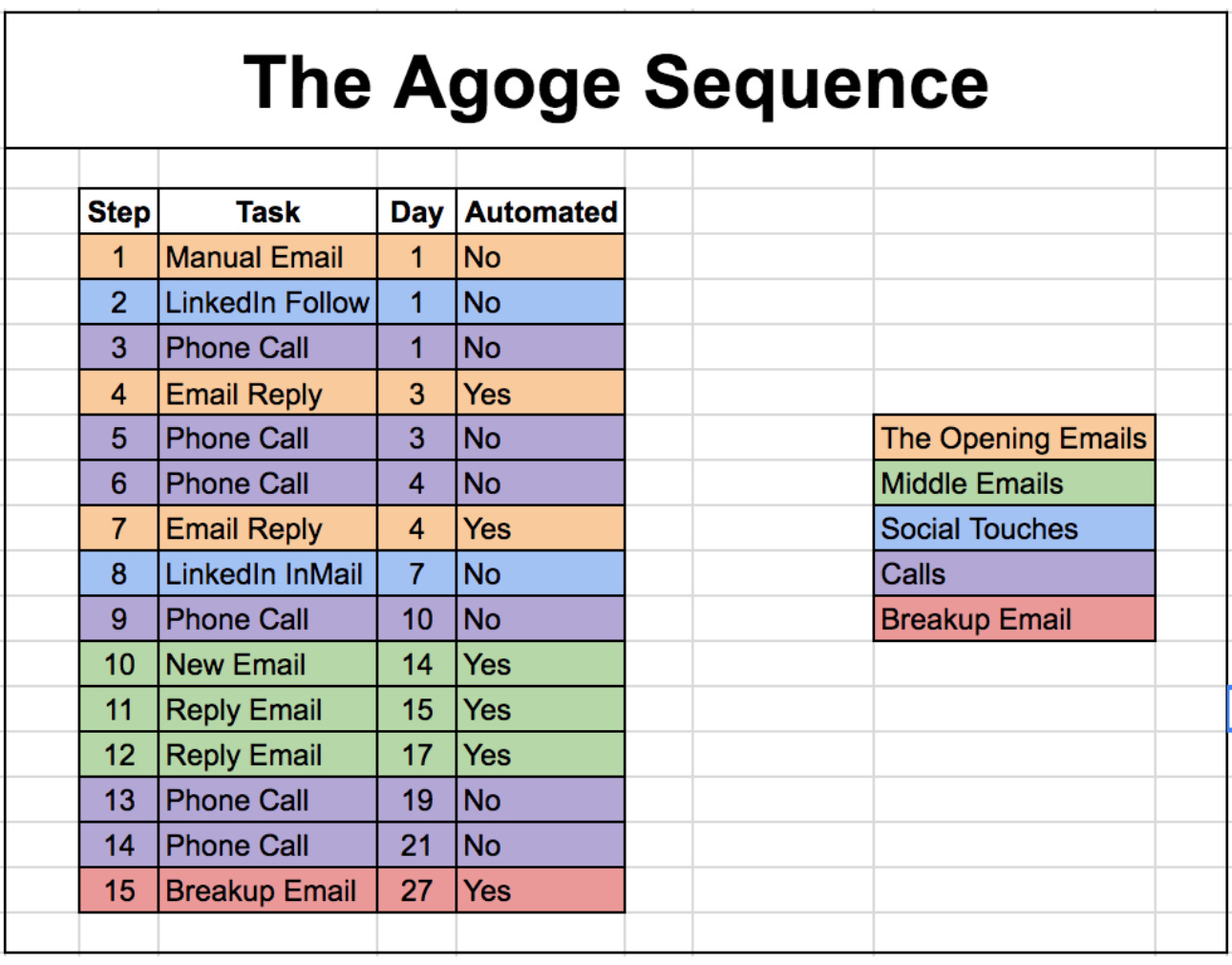88. Effective Cold Email Techniques: From Subject Lines to CTAs
Last week, I outlined my 3 step process for sending cold emails that get a response:
industry and prospect research;
copywriting emails and sequence building;
testing emails and reviewing results.
I broke down the first step - industry and prospect research - here.
This week, I’m outlining the second step - copywriting and sequence building.
I’ll cover two things:
The universal rules for writing an effective cold email and
A sequence framework that led to 12 opportunities in 8 weeks.
Let’s jump in.
In today’s email:
The Anatomy of an Effective Cold Email
Two Rules
The Agoge Sequence
👇🏾 Listen: How I sprint to sales success!
THE BIG IDEA
The Anatomy of an Effective Cold Email
The widely accepted structure of an effective cold email consists of:
Subject Line
Preview Line
Value Prop
CTA
Subject Line
The subject line is the first thing a prospect sees on their phone or inbox.
They’re important, but not that important.
The right subject line needs to create curiosity so your email gets opened.
Here are 3 of my favourite subject line frameworks:
Framework 1: Match the subject line to your body copy:
help with {challenge}
interested in waste collections?
can we talk about waste clearances for {company}?
Framework 2: Ask a quick question
quick q
quick question {prospect first name}
quick question about {company}
Framework 3: Mentioning a mutual connection
{mutual connection} told me to reach out
{mutual connection} sent me
{mutual connection name}
Two useful tips that I’ve learned are:
Keeping the subject line short - 4-5 words max; and
Use lowercase, casual writing to avoid looking like a marketing email.
Preview Line
The preview line is the short message that’s visible in your inbox without opening the email.
Preview lines should make it obvious that you know the prospect and create curiosity for them to read further.
Here are some preview lines I’ve used recently:
“As a housing leader, do you have to manage tenant turnovers and ensure properties are let quickly to minimise lost rental income?”
“I called the office recently and they referred me to you as the best person to speak with about waste clearances.”
“Do you have to manage clearance costs while reducing voids and minimising lost rental income?”
The context of the preview line varies depending on who you sell to.
I use ChatGPT to identify the biggest challenges/problems faced by a key decision-maker and use this for context in my preview line.
For example:
Housing officers must get vacant properties back on the market quickly. Void rates impact rental income, which impacts the revenue generated by a housing association.
I used this preview line: “As a housing leader, do you have to manage tenant turnovers and ensure properties are let quickly to minimise lost rental income?”
Value Prop
The value prop ties the subject line, preview line and CTA together.
I use this 4-step framework for creating a killer value proposition.
I only use one value proposition per email. This keeps emails nice and short.
Plus, I can use multiple value props across several emails instead of trying to fit them all into one.
Here are some recent value props I’ve used:
“I’m asking because 85% of property service officers spend hours collecting 3 quotes from waste clearance suppliers to get the best price. Valuable time that could be spent getting the property ready for new tenants.”
“We help housing associations like Barnsbury HA and Theori Housing reduce their spending on void clearances and bulky waste collections while improving service quality and performance.”
“Curious if you're open to chat re: rebate program for waste collections? You could claim up to 7% of your annual spend on waste via quarterly payouts.”
CTA
I set one of two objectives when I send a cold email:
to share something (brochure, video, resource, etc.); or
to set a meeting.
That’s it.
Either way, you must motivate the prospect to take the next step.
My most used CTA’s are:
Would you like more details?
Can I send you a {brochure/short video} to explain how LITTA can help?
What’s the best way to schedule 5 minutes to talk?
Do you have some time later this week to discuss this?
Can I grab 10 minutes of your time to chat?
Are you available for a 10-minute chat on {Day} or {Day} at {Time}?
Worth a conversation or no?
What’s the best way for us to connect?
Two Rules
Rule 1 - keep it short
Cold emails need to be short and concise.
What’s the minimum a person needs to know for your message to make sense?
Delete everything else.
Short, easily digestible emails boost your chances of a response.
I have a 45% response rate with this email:
Rule 2 - ask one thing
A cold email isn’t meant to ask multiple questions.
It only needs one call to action.
What is the next step you want the prospect to take?
Ask just for that.
In most cases, your question will be:
ask permission for something (sending a deck or video);
ask to validate something (a problem or challenge); or
ask for a call or meeting.
In the email above, my only question is asking for a call: “Worth a chat?”.
The Agoge Sequence
A year ago, I struggled to build a good outbound sequence.
Then I read this Sam Nelson post which broke down his Agoge Sequence.
The Agoge sequence is a fifteen-step, multi-channel sequence designed to get you in front of high-quality prospects.
I built The first Agoge sequence for a recent housing association prospecting sprint.
The sequence took 25 working days (5 weeks) to complete and included:
7 emails
6 calls
2 LinkedIn actions
I targeted 4 different decision makers and built two sequences per decision maker (8 in total).
Once built, all I had to do was enrol contacts and complete the actions in my task list.
On average, the sequences I built generated a 29.2% reply rate
If you want access to the full sequence, comment on this post, and I’ll share Google Docs with all the steps.
Now, the Agoge sequence is my go-to framework for prospecting sprints.
The added bonus of building the 15-step sequence is that it can be repurposed into smaller 6-, 7-, and 8-step sequences.
Thanks for reading!
Matt @ The Growth Lab
Forwarded this email?
Subscribe here:
Thanks for subscribing to The Growth Lab.








